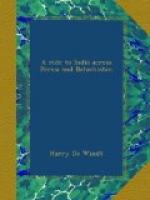Nasr-oo-din has three legal wives, and an unlimited number of concubines. Of the former, the head wife, Shuku-Es-Sultana, is his own cousin and the great-granddaughter of the celebrated Fatti-Ali-Shah, whose family was so large that, at the time of his death, one hundred and twenty of his descendants were still living. Shuku-Es-Sultana is the mother of the “Valliad,” or Crown Prince, now Governor of Tabriz. The second wife is a granddaughter of Fatti-Ali-Shah; and the third (the Shah’s favourite) is one Anys-u-Dowlet. The latter is the best looking of the three, and certainly possesses the greatest influence in state affairs. Of the concubines, the mother of the “Zil-i-Sultan” ("Shadow of the King”) ranks the first in seniority. The Zil-i-Sultan is, though illegitimate, the Shah’s eldest son, and is, with the exception of his father, the most influential man in Persia, the heir-apparent (Valliad) being a weak, foolish individual, easily led, and addicted to drink and the lowest forms of sensuality.
With the exception of eunuchs, no male person over the age of ten is permitted in the seraglio, or anderoon, which is constantly receiving fresh importations from the provinces. Persians deny that there are any European women, but this is doubtful. The harems of Constantinople and Cairo are recruited from Paris and Vienna; why not those of Teheran? The indoor costume of the Persian lady must be somewhat trying at first to those accustomed to European toilettes. The skirt, reaching only to the knee, is full and bouffe, like an opera-dancer’s, the feet and legs generally bare. The only becoming part of the whole costume is the tightly fitting zouave jacket of light blue or scarlet satin, thickly braided with gold, and the gauze head-dress embroidered with the same material, and fastened under the chin with a large turquoise, ruby, or other precious stone.
Some of the women (even among the concubines) are highly educated; can play on the “tar”, [E] or harmonica, sing, and read and write poetry; but their recreations are necessarily somewhat limited. Picnics, music, story-telling, kalyan and cigarette smoking, sweetmeat-making, and the bath, together with somewhat less innocent pastimes, form the sum total of a Persian concubine’s amusements. Outside the walls of the anderoon they are closely watched and guarded, for Persians are jealous of their women, and, even in the most formal social gatherings, there is a strict separation of the sexes. Its imperial master occasionally joins in the outdoor amusements of his harem; indeed, he himself invented a game a few years since, which sounds more original than amusing. A slide of smooth alabaster about twenty feet long, on an inclined plane, was constructed in one of his bath-houses. Down this the Shah would gravely slide into the water, followed by his seraglio. The sight must have been a strange one, the costumes on these occasions being, to say the least of it, scanty!




